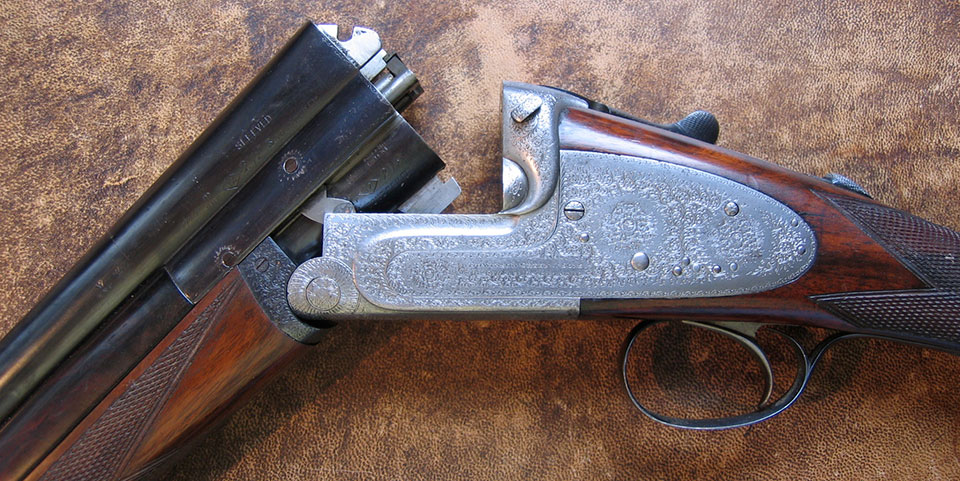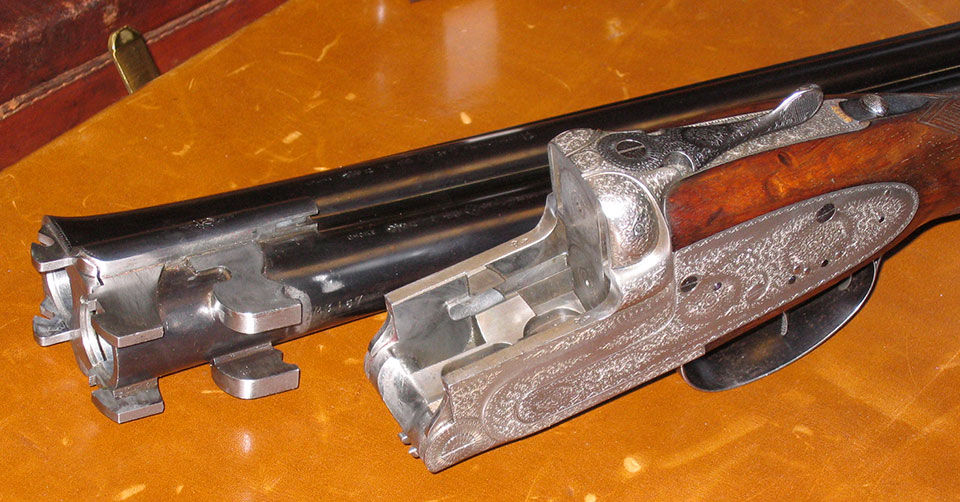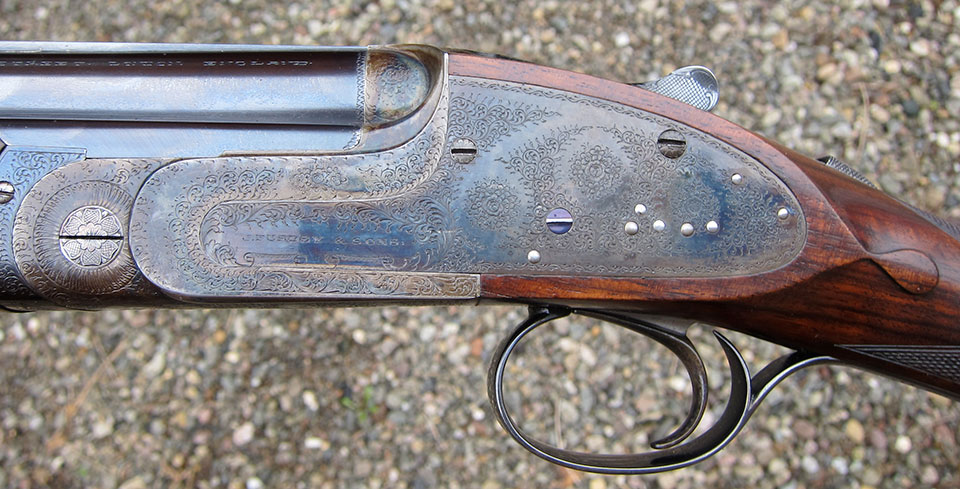Although 2024 marks the seventy-fifth anniversary of Purdey’s purchase of James Woodward & Sons, the company’s history with over & under guns started just over a century ago, writes Dr. Nicholas Harlow.
When the company’s Chairman, Athol Purdey, visited New York in April 1922, Von Lengerke & Detmold appear to have placed orders for both over & under and single-barrelled trap guns. However, unlike many London gunmakers, Purdey had not created such designs, leaving Athol somewhat on the back foot.
Upon his return to London in May, he tasked his factory manager, Ernest Lawrence Senior, with creating a single-barrelled action first, which was half of a Beesley action. Once that was done, the factor then moved to building an over & under, which was to be based around Edwinson Green’s design. The first Purdey over & under gun, No. 22,564, was essentially a clone of an Edwinson Green gun, No. 6896. Athol purchased it as a pattern gun from the Strand-based pawnbroker and gun dealer, C.B. Vaughan, and both prototype and pattern were stored in the basement of Audley House until they were sold to Vaughan in 1935 and 1937 respectively.
Having built the prototype, Ernest and his son, Harry, set about modifying the action to meet Purdey’s requirements, as well as avoiding infringing any existing patents. The first example, No. 22,900, was completed in October 1925, but just twenty-seven were completed before the outbreak of the war, with the last one being sold from stock in 1942.
Harry Lawrence recorded his own history of over & under development at Purdey before his death in 1984. Although this has been the basis for what has been written about these guns ever since, there are certain points which do not match either the records or those guns that could be examined. As such, it seems that this story may need revision.

While Harry described Edwinson Green’s design as having ‘6 locking bolts’, this is not the case. The Edwinson Green action used the classic Purdey bolts on the underside of the barrel, engaging with a full-width cross-pin, and a pair of cross-bolts on the breech-face, giving a total of four locking bolts. When Harry and his father created the Purdey action, they retained the full-width cross-pin but moved the bolts to the walls of the action, giving two on each side and a total of six bolts.
After Athol Purdey retired in 1928, Tom Purdey apparently allowed them to redesign the action to change ‘…the method of cocking the locks which in the original guns was very heavy.’ Sometime later, Harry was apparently allowed to remove the front two grips, meaning that the later actions should only have four bolts. However, while a change in the jointing did alter the cocking arrangement of the action, no evidence can be found that the number of bolts was reduced as Harry claimed, and they appear on the two final guns built.
Tom Purdey apparently allowed them to redesign the action
While Harry was not the only actioner to work on over & under guns, he actioned thirteen of the fifteen guns completed between 1925 and 1935. At that time, he was increasingly involved in the running the factory, and so passed the actioning duties to Len Howard, starting with No. 24,723, which they actioned together. Len Howard actioned the final eleven, completing the final gun, No. 25,720, in the autumn of 1939.
This handover also suggests that any major changes to the action were carried out between 1928 and 1935. Based upon guns that could be examined, the design remained relatively unaltered up to at least No. 23,833, which was completed in 1930. Howard’s second gun, No. 24,863, was completed as stock in 1937 and incorporates several modifications that also appear on the last action made, No. 25,720.
While the early actions are relatively tall and flat sided, the later actions are readily identifiable by their teardrop-shaped bolsters. Internally, the full-width cross-pin has been replaced by Woodward-style trunnions, and the barrel loops are now sat on the sides of the bottom barrel rather than below, creating a much lower action profile.
The change also necessitated moving the Woodward-style cocking rods to accommodate the barrels. One of the other changes that Harry mentions in his notes was that he put ‘the forend loops on the side of the barrels’ to improve the cocking action of the gun. Looking at the later guns, while the forend-loop (to which the forend attaches) remains in the conventional place, both of the later actions have a wedge on each side of the barrels, which bear upon a Boss-style forend-iron.
These hold the forend firm against the knuckle as the gun opens, assisting in cocking the gun. As such, it seems that the ‘improved’ action that was being built by the mid-1930s was a hybrid, combining Edwinson Green’s cross-bolt, the trunnion joint and cocking of a Woodward and elements from Boss’ forend arrangement. Both Purdey designs also have projections on the forend-irons that connect to slots in the action-knuckle, locking them together when the gun is closed.

While it is hard to generalize about a design when so few were made, two things are worth noting. The first is that, throughout the relatively brief period that they were offered, they were the most expensive over & under action on the market. While a similar gun by Boss started at £157 10s, and from £150 for a Woodward, the Purdey was £170 until 1938, when it was increased to £175.
They were also omitted from Purdey’s 1931 catalogue, and they do not appear to have been discussed in the Board minutes whenever pricing was being considered. As such, while Purdey were able to supply an over & under if asked, they do not seem to have been interested in promoting it.
This may well have been due to the nature of the action that they were using, rather than a lack of conviction in their product, as Athol Purdey reportedly considered the Edwinson Green design ‘the strongest Over & Under gun that he had seen.’ However, Tom and Jim Purdey were fairly dismissive of over & under guns in their 1936 book, The Shot-Gun.
The second point is perhaps more subjective, and relates to the weight of the guns. It has often been said that these original over & under guns are overly heavy and cumbersome. Harry’s notes show that he was aware that they weren’t perfect, and modified the design to improve their handling. However, it is also worth looking at what the guns were being built for. Most of the 12-Bores that were built were intended for pigeon or trap shooting, and so generally weighed between 8lbs. and 8½lbs.
This was comparable to the guns that Woodward were putting out in a similar configuration at that time, and even today would be considered reasonable when building guns for 1¼oz. (about 35g) loads.
Those 12-Bore guns built for game shooting, as well as 16- and 20-Bores, were generally much lighter, weighing in between 7¼lbs. and 7¾lbs. for a 12-Bore and down to around 6lbs. for a 20-Bore.These are also comparable to similar contemporary Woodwards, and even slightly lighter than the guns being built today. As such, while they may have been cumbersome to operate, it seems unreasonable to describe them as overly heavy.
An ‘experimental’ action, No. 25,654, had been started just before the outbreak of war
Post-war, Purdey appears to have been in a difficult place regarding over & under orders. An ‘experimental’ action, No. 25,654, had been started just before the outbreak of war, but as far as Purdey’s records are concerned never progressed beyond the action stage. It has not been seen since 1949.
Len Howard left the firm in 1947 when he was asked to step down as Foreman of the factory in favour of Harry Lawrence, leaving Purdey without an over & under actioner. Although they had received two orders for such guns in 1946, it is unclear from the records how Purdey intended to fulfil them. As such, Charles Woodward’s visit to Audley House in the Spring of 1948 was extremely opportune. Not only did it provide Purdey with a far more popular action, but the impetus to put it into production.
The sale contract included a clause stating that, if they didn’t work the action within two years, the rights would revert to Charles Woodward. Over the last few months of 1948, his last actioner, Frank Banister, taught Harry’s younger brother, Ernest Jr., how to build the action.
The first Purdey example, No. 26,113, was Sir Joseph Nickerson’s ‘3in. Magnum’ 12-Bore, and was completed in February 1950, just over a year after the sale of the company was completed.

Published by Vintage Guns Ltd on (modified )




